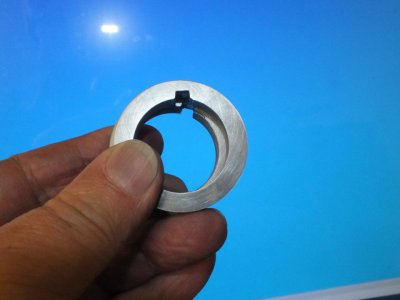- Joined
- Jun 29, 2014
- Messages
- 4,059
As part of my CNC Lathe build, I need to install some pulleys on the spindle drive. The easiest method for making a key way in a pulley is to broach the feature into to part. I'm facing two challenges in using this traditional method: no arbor press and no broach tooling.
O.k., alternative methods are:
There is an alternative, that sort of uses a slotter type arrangement, but without all of the horsepower behind a machine.
Here is my setup:
View media item 98071
Several keypoints that allow this to work successfully:
Here is how I indicate a horizontal reference:
View media item 98072
In this photo, you can see how I used the combination square to do three things simultaneously:
From there, I took small bites (.005-.010) with some cutting oil until I reached my desired depth. In these photos, I could hog out .008-.010 passes in the brass sleeve. In the steel pulley, I couldn't bite more than .005" at a time, so that required many passes. This was done by advancing the carriage longitudinally along the lathe bed.
View media item 98073
Result was nice, straight keyways to the desired depth. I was skeptical, but these ended up with snug fits, if not near perfect sliding fits with a little fine filing.
View media item 98074
O.k., alternative methods are:
- to use a slotter attachment on a milling machine. I'm in the middle of 7,000 projects, can't take on one more,
- hand file,
- hand scraping.
There is an alternative, that sort of uses a slotter type arrangement, but without all of the horsepower behind a machine.
Here is my setup:
View media item 98071
Several keypoints that allow this to work successfully:
- You must be able to lock your spindle,
- You must be able to accurately locate a horizontal reference across the workpiece,
- You must be able to index the cutting tool on the crosslide,
- You need to allow for clearance of the tool to pass through the workpiece while being held in the chuck,
- You need to grind a tool accurately,
- You need to be able to locate the tool in such a way that it is index perpendicularly to the wall of the pulley.
Here is how I indicate a horizontal reference:
View media item 98072
In this photo, you can see how I used the combination square to do three things simultaneously:
- Find center of the part,
- Find horizontal reference across the part, using the spirit level,
- Marking the horizontal reference using the straightedge.
From there, I took small bites (.005-.010) with some cutting oil until I reached my desired depth. In these photos, I could hog out .008-.010 passes in the brass sleeve. In the steel pulley, I couldn't bite more than .005" at a time, so that required many passes. This was done by advancing the carriage longitudinally along the lathe bed.
View media item 98073
Result was nice, straight keyways to the desired depth. I was skeptical, but these ended up with snug fits, if not near perfect sliding fits with a little fine filing.
View media item 98074


